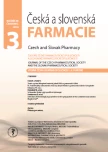-
Medical journals
- Career
Theory and practice of pharmacopoeial control of quality of drugs and excipients IX. The problem of tolerance limits for the content of active substances and excipients in the European Pharmacopoeia (Ph. Eur.)
Authors: Jan Šubert; Jozef Kolář
Published in: Čes. slov. Farm., 2019; 68, 91-94
Category: Review Articles
Overview
Content tolerance limits should respect the acceptable variation in the content of the active substance or excipient from its production and the variability of the results of the analytical procedure prescribed to determine the content by the appropriate pharmacopoeia. This usually prevails in the active substances and excipients. They should be derived statistically based on the precision of the prescribed analytical method determined by the interlaboratory test. Calculations from published precision characteristics show that some tolerance intervals for the active substance content are probably too narrow in Ph. Eur. This can lead to erroneous decisions about their quality.
Keywords:
Ph. Eur. – determination of active substance content – interlaboratory study – statistical tolerance limits
Sources
1. Reimers F. The Basic Principles for Pharmacopoeial Tests. Copenhagen, London: Ejnar Munksgaard, Heinemann Medical Books 1956; 76.
2. Fürst W. Zur Bedeutung der Standardabweichung für die Aufstellung von Arzneibuchmonografien. Zbl. Pharm. 1973; 112, 701–710.
3. Diding N., Johansson S., Ohlson B., Öhrner B. Anforderungen an Präzision, Genauigkeit und Spezifität von Gehaltsbestimmungen unter Verwendung von Standards. Zbl. Pharm. 1981; 120, 779–788.
4. Československý lékopis, 3. vydání, svazek II. Praha: Avicenum 1970; 463–464.
5. Sachs L. Angewandte Statistik. 4. Aufl. Berlin, Heidelberg, New York: Springer-Verlag 1974.
6. Eckschlager K., Horsák I., Kodejš Z. Vyhodnocování analytických výsledků a metod. Praha: SNTL 1980.
7. Youden W. J., Steiner E. H. Statistical Manual of the AOAC. Washington: Association of Official Analytical Chemists 1975.
8. Šubert J., Grolichová L. Ke kvantitativnímu hodnocení léčiv v ČsL 3. XVI. Stanovení obsahu krystalického dusičnanu stříbrného – kruhový test. Farm. Obzor 1986; 55, 25–28.
9. Československý lékopis, 4. vydání, svazek II. Praha: Avicenum 1987; 101.
10. European Pharmacopoeia Online 9.5 (http://online6.edqm.eu/ep905/ Accessed 05-02-2019).
11. Daas A. G. J., Miller J. H. McB. Content limits in the European Pharmacopoeia (Part 1). Pharmeuropa 1997; 9, 148–156.
12. Daas A. G. J., Miller J. H. McB. Content limits in the European Pharmacopoeia (Part 2). Pharmeuropa 1998; 10, 137–146.
13. Margosis M., Horwitz W., Albert R. Performance characteristics of methods of analysis used for regulatory purposes. I. Drug dosage forms. F. Gravimetric and titrimetric methods. J. Assoc. Off. Anal. Chem. 1988; 71, 619–635.
14. Horwitz W., Albert R. H. Performance characteristics of methods of analysis used for regulatory purposes. I. Drug dosage forms. D. High pressure liquid chromatographic methods. J. Assoc. Off. Anal. Chem. 1985; 68, 191–198.
15. Jílek M. Statistické toleranční meze. Praha: SNTL 1988.
16. Jílek M. Počet měření a odhad přesnosti chemických analýz. Chem. Listy 1981; 75, 937–946.
17. Dong X., Tsong Y., Shen M., Zhong J. Using tolerance intervals for assessment of pharmaceutical quality. J. Biopharm. Stat. 2015; 25, 317–327. doi:10.1080/10543406.2014.972512.
18. De Beer J. O., De Spiegeleer B. M. J., Hoogmartens J., Samson I., Massart D. L., Moors M. Relationship between content limits and assay methods: an interlaboratory statistical evaluation. Analyst 1992; 117, 933–940.
19. Šubert J., Grolichová L. Ke kvantitativnímu hodnocení léčiv v ČsL 3/ČsL 4. XX. Stanovení obsahu trometamolu a benzoové kyseliny – kruhový test. Českoslov. Farm. 1988; 37, 133–137.
20. Ebel S. Assay content limits in the pharmacopoeia. Pharmeuropa 1997; 9, 143–147.
21. van Rompay J. How to construct and use the specifications of chemical substances. Pharmeuropa 1997; 9, 135–139.
22. van de Vaart F. J. Content limits – setting and use. Pharmeuropa 1997; 9, 140–143.
Labels
Pharmacy Clinical pharmacology
Article was published inCzech and Slovak Pharmacy

2019 Issue 3-
All articles in this issue
- Theory and practice of pharmacopoeial control of quality of drugs and excipients IX. The problem of tolerance limits for the content of active substances and excipients in the European Pharmacopoeia (Ph. Eur.)
- Schisandra chinensis and its phytotherapeutical applications
- XLI. pracovní dny Radiofarmaceutické sekce České společnosti nukleární medicíny ČLS JEP
- Zemřel pan docent RNDr. Pavel Komárek, PhD. † 8. července 2019
- Selection of technological parameters for the preparation of the combined oral solution Maglycimet™
- Czech and Slovak Pharmacy
- Journal archive
- Current issue
- Online only
- About the journal
Most read in this issue- Schisandra chinensis and its phytotherapeutical applications
- Theory and practice of pharmacopoeial control of quality of drugs and excipients IX. The problem of tolerance limits for the content of active substances and excipients in the European Pharmacopoeia (Ph. Eur.)
- XLI. pracovní dny Radiofarmaceutické sekce České společnosti nukleární medicíny ČLS JEP
- Selection of technological parameters for the preparation of the combined oral solution Maglycimet™
Login#ADS_BOTTOM_SCRIPTS#Forgotten passwordEnter the email address that you registered with. We will send you instructions on how to set a new password.
- Career

